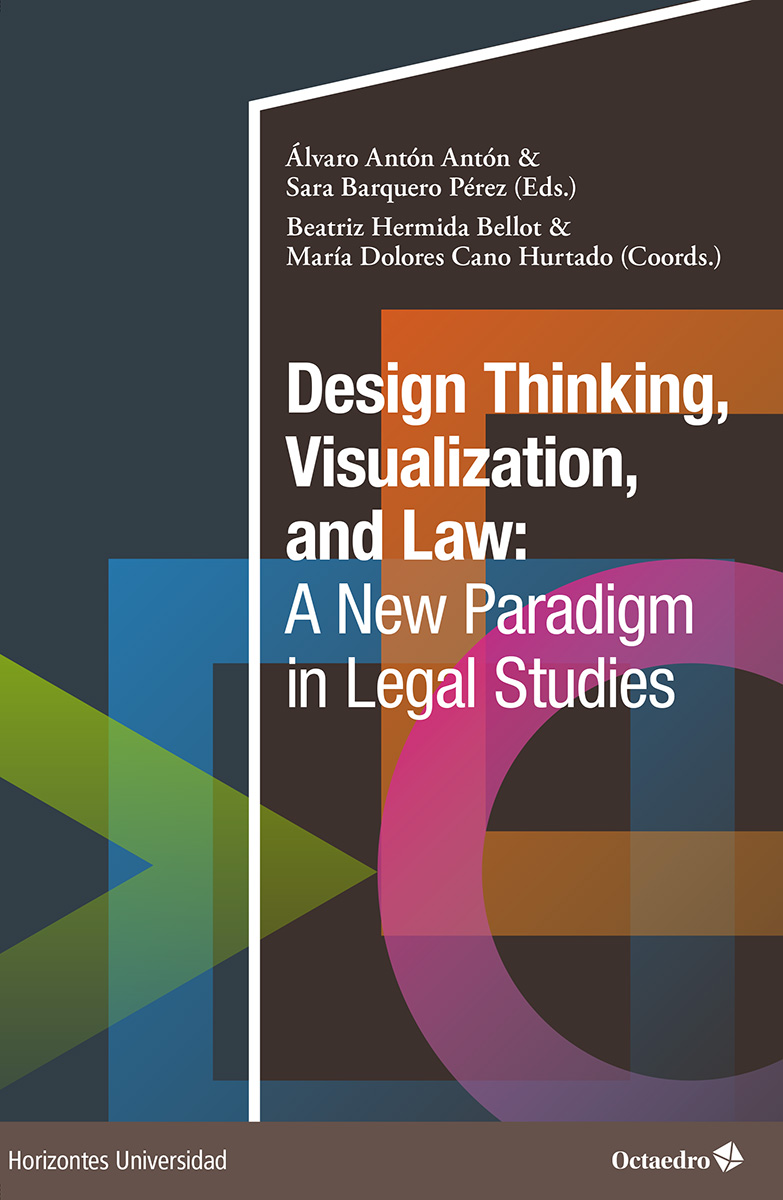FICHA TÉCNICA
EDICIÓN IMPRESA:
ISBN: 9788410054677
Referencia: 09623-0
Fecha: junio, 2024
Encuadernación: rústica
Tamaño: 15 x 23 cm
Páginas: 312
PDF:
ISBN: 9788410054684
Referencia: 09623-1
Fecha: septiembre, 2024
Tamaño: 312
Design Thinking, Visualization and Law: A New Paradigm in Legal Studies
24,00€
EDICIÓN IMPRESA
Disponible en descarga gratuita:
Presentación
In an era where the law becomes increasingly complex, Design Thinking, Visualization, and Law: A New Paradigm in Legal Studies emerges as a groundbreaking work that revolutionizes our approach to legal education and practice. Edited by Álvaro Antón Antón and Sara Barquero Pérez, and coordinated by Beatriz Hermida Bellot and María Dolores Cano Hurtado, this collection of essays and studies paves the way for a more accessible and understandable legal system through the innovative application of design thinking and visualization techniques.
The book is divided into four parts, each meticulously addressing the multifaceted relationship between legal studies, EU law and policies, and the transformative power of design thinking: Part I: The Theoretical Framework introduces the revolutionary concept of Legal Design Thinking, offering insights into its methodology and its potential. Part II: Practical Applications from Legal Sciences – EU Law and Policies showcases concrete examples of how design thinking and visualization can simplify and elucidate complex legal concepts, making EU law more accessible. Part III: Practical Applications from Legal Sciences – Private and Public Law explores the application of person-centered legal design in various legal fields, demonstrating its efficacy in enhancing understanding and accessibility. Part IV: Multidisciplinary Experience delves into the interdisciplinary nature of legal design, illustrating its impact beyond legal studies to encompass areas such as education science, political science, and the circular economy.
Design Thinking, Visualization, and Law: A New Paradigm in Legal Studies is a book calling for a shift in how we teach, learn, and practice law. It is an essential read for legal professionals, educators, students, and anyone interested in the future of legal education and practice. This volume invites us to envision a legal system that is not only intellectually rigorous but also profoundly human-centered, accessible, and engaging.
Índice
Foreword (Álvaro Antón Antón)
PART I: THE THEORETICAL FRAMEWORK
1. Revolutionizing Legal Education: The Jean Monnet Project on Legal Design Thinking and Legal Visualization, towards an Understandable EU Law (Dr. Álvaro Antón Antón)
2. Design Thinking: Methodology of Application in Other Disciplinary Environments. Application Tools: Legal Design Thinking and Visual Design Thinking (Dra. Sara Barquero Pérez)
PART II: PRACTICAL APPLICATIONS FROM LEGAL SCIENCES – EU LAW AND POLICIES
3. Legal Design Thinking in Communication about Relevant Jurists (Dra. Sara González Sánchez; Dr. Antonio López Álvarez)
4. A Teaching Experience on the Use of Human Centered Design and its Techniques on the Social Network Instagram, in the Service of the General Objective of the European Year of Youth (Dra. Adela M. Aura Larios de Medrano)
5. The Omnibus Directive for Algorithmic Price Customisation in E-Commerce: Using “Legal Design Thinking” Methodology for Contracting in the Digital Age (Ms. María Luisa Mena Durán)
PART III: PRACTICAL APPLICATIONS FROM LEGAL SCIENCES – PRIVATE AND PUBLIC LAW
6. Person-Centred Legal Design: A Technique for Making the Exercise of Testamentary Capacity an Accessible Right for Persons with Disabilities (Dra. Beatriz Hermida Bellot)
7. Principles of Human-Centered Design in Law Studies: Legal Design and Legal Visualization Techniques to Facilitate the Understanding of Mortgage and Real Estate Purchase and Sale Clauses (Dr. Esperanza Ferrando Nicolau)
8. Legal Design Thinking and Legal Visualisation in the Framework of Fundamental Rights: the Right of Parents to Choose their Children’s Education and the Obligation of the State (Dra. Mª Rosa García Vilardell)
9. The Application of Legal Design for a Better Understanding of the Special Civil Proceedings of the Civil Procedure Law (Dr. Rosa Pascual Serrats)
10. Application of the Legal Design Thinking and Legal Visualization Methodology to Facilitate the Understanding of Child Abduction Regulations (Dra. María Dolores Cano Hurtado)
11. Legal Design Focused on Legal Persons: How to Make Stakeholders Distinguish between a Foundation and an Association, between a Civil and a Canonical Foundation (Autonomous or Non-autonomous) and between a Civil and a Canonical Association? (Dr. Remigio Beneyto Berenguer)
12. Application of Legal Design and Legal Visualisation Techniques to Facilitate the Understanding of Basic Criminal Law Concepts (Dra. María Asunción Chazarra Quinto)
13. Principles of Human-centered Design in Civil Family Law: Application of the Legal Design and Legal Visualisation Methodologies to Facilitate Understanding of Separation, Divorce and Marital Nullity (Dra. María Dolores Cano Hurtado)
14. Legal Design Thinking and Legal Visualisation in the Context of Teaching Canonical Marriage Law and its Application in Ecclesiastical Courts (Dr. M. Rosa García Vilardell)
PART IV: MULTIDISCIPLINARY EXPERIENCE: THE FINAL PART OF THE BOOK EXPLORES THE APPLICATION OF DESIGN AND VISUAL THINKING TECHNIQUES IN MULTIDISCIPLINARY CONTEXTS
15. The Relationship between Constitutional Law and Political Science. The Use of the Techniques of Legal Design and Legal Visualisation to Understand the Functioning of the Electoral System and its Regulation (Dra. Marta Pérez Gabaldón)
16. Design Thinking and Visual Thinking Techniques to Move towards a Circular Economy. Multidisciplinary Application in University Students (Dra. María Pilar García-Alcober; Dr. Valentín Gallart-Camahort)
17. Design Thinking in the Service of Children in Hospital. Ensuring the Right to Education within the European Legislative Framework (Dra. Marta Ruiz Revert)
Álvaro Antón Antón, Beatriz Hermida Bellot, María Dolores Cano Hurtado, Sara Barquero Pérez
9788410054677
9788410054684
09623-0
09623-1
